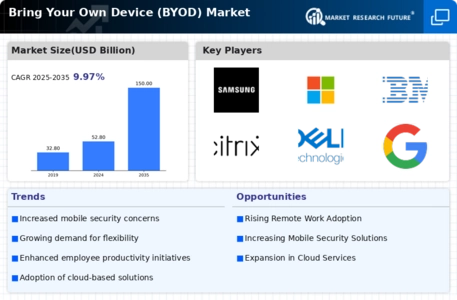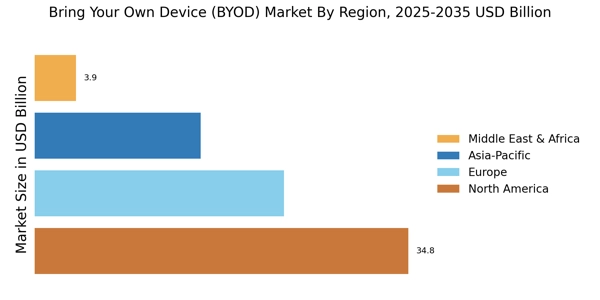Growing Mobile Workforce
The Bring Your Own Device Market (BYOD) Market is also propelled by the growing mobile workforce. As more employees work remotely or in flexible environments, the need for mobile access to corporate resources becomes paramount. This trend is reflected in the increasing number of remote workers, which has been projected to reach 50% of the workforce in the coming years. The BYOD model allows employees to utilize their preferred devices, ensuring they remain connected and productive regardless of their location. This shift towards a mobile workforce necessitates robust BYOD policies to manage security and compliance effectively. Consequently, the rise of the mobile workforce is likely to continue driving the BYOD market forward.
Technological Advancements
Technological advancements play a crucial role in shaping the Bring Your Own Device Market (BYOD) Market. The rapid evolution of mobile technology, including the proliferation of smartphones and tablets, has made it easier for employees to integrate their personal devices into the workplace. Enhanced connectivity options, such as 5G networks, further facilitate seamless access to corporate resources. Additionally, advancements in security technologies, such as biometric authentication and encryption, help address concerns related to data security in a BYOD environment. As technology continues to evolve, it is expected that the BYOD market will expand, driven by the increasing capabilities of personal devices and the need for organizations to adapt to these changes.
Cost Efficiency and Savings
The Bring Your Own Device Market (BYOD) Market is increasingly driven by the potential for cost efficiency and savings. Organizations that adopt BYOD policies often experience reduced hardware and software expenses, as employees utilize their personal devices for work purposes. This shift can lead to significant savings on device procurement and maintenance costs. According to recent data, companies can save up to 30% on IT expenditures by implementing BYOD strategies. Furthermore, the reduction in the need for extensive IT support for company-owned devices can free up resources for other critical areas. As businesses continue to seek ways to optimize their budgets, the allure of cost savings associated with BYOD is likely to propel its adoption further.
Enhanced Employee Productivity
The Bring Your Own Device Market (BYOD) Market appears to be significantly influenced by the enhancement of employee productivity. When employees are allowed to use their personal devices, they often feel more comfortable and efficient in their work. This flexibility can lead to increased job satisfaction and, consequently, higher productivity levels. Studies indicate that organizations implementing BYOD policies report a productivity increase of approximately 20 to 30%. Employees can access work-related applications and data from anywhere, facilitating a more agile work environment. As the demand for flexible work arrangements continues to rise, the potential for improved productivity through BYOD is likely to remain a key driver in the market.
Increased Focus on Data Security
The Bring Your Own Device Market (BYOD) Market is increasingly influenced by the heightened focus on data security. As organizations embrace BYOD policies, they face the challenge of protecting sensitive information accessed through personal devices. This concern has led to the development of advanced security solutions, including Mobile Device Management (MDM) and endpoint security measures. According to industry reports, nearly 70% of organizations implementing BYOD have prioritized data security as a critical component of their strategy. The need to safeguard corporate data while allowing employees the flexibility of using their devices is likely to drive innovation in security technologies, further shaping the BYOD landscape.

















Leave a Comment